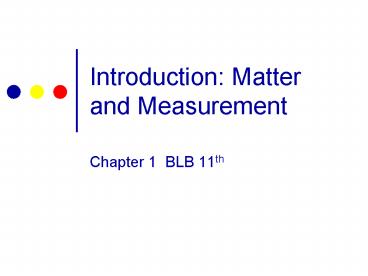Introduction: Matter and Measurement PowerPoint PPT Presentation
1 / 35
Title: Introduction: Matter and Measurement
1
Introduction Matter and Measurement
- Chapter 1 BLB 11th
2
1.1 The Study of Chemistry
- Chemistry is everywhere!
- Matter is everywhere!
- Thus, chemistry matters!
- Chemistry involves the study of matter its
properties and behavior. - Macroscopic observations are rooted in
microscopic structure.
3
Why study chemistry?
- Its required.
- It sounds interesting.
- Its unavoidable.
- It truly is the central science.
- Name an element
- Name a compound
- Name a mixture
4
The Periodic Table of the Elements
5
Molecules
- O2, H2O, CO2, C2H5OH, C2H6O2, C9H8O4
- Models
- Shown on p. 2
6
Expectations
- Classify matter
- Properties of matter
- g ? mL (using density)
- Solve for any variable in a formula.
- Metric unit conversions
- Other conversions temperature, metric-English,
etc. - Identify and work with significant figures.
7
1.2 Classification of Matter
- Matter anything which has mass and takes up
space. - States of matter (p. 5)
- Solid rigid, regular
- Liquid fluid, irregular
- Gas open, random
- Phases of matter
8
States of Matter
9
States of Matter
10
Alternative diagram to that on p. 9
11
(No Transcript)
12
(No Transcript)
13
Atoms are the building blocks of matter.
14
The Periodic Table of the Elements
15
Elements
16
Group Activity
- Get into groups of four or five. No solo flyers!
- Introduce yourself.
- Work together.
- Discuss, argue, and intellectually engage.
- Choose a person to record and report the groups
result.
17
Problem 1
- Describe the contents of the containers.
- Devise a plan to determine which liquid is in
each of the two containers.
18
Description
19
Strategy for identification
20
1.3 Properties of Matter
- physical measured or observed without changing
the identity of a substance, e.g. physical state,
color, odor, density, boiling point - chemical describes a substances reactivity,
e.g. flammability, corrosiveness - extensive depends on the amount of matter
present, e.g. mass, volume - intensive does not depend on the amount of
matter present, e.g. density, color, temperature
21
Physical Chemical Changes
- Physical change in appearance, not in
composition, e.g. phase changes, separation of
mixtures filtration, distillation,
chromatography (p. 12) - Chemical new substance is formed as the
chemical identities change, e.g. any chemical
reaction (pp. 10-11) - Dissolve vs. react
- Explode vs. ignite
22
1.4 Units of Measurement (SI Units)
23
Volume a derived unit
24
Metric Prefixes
Angstrom Å 10-10 m
25
Temperature Scales
26
Temperature Conversions
- F ? C
- C ? F
- C ? K
27
Density
- Density mass per unit volume
- D m/V (g/cm3 or g/mL)
- Measured at a specific temperature
- Useful as a conversion factor (g ? mL)
- Most substances become more dense at lower
temperatures. - Specific gravity density of a substance divided
by the density of a reference substance (usually
water) no units
28
Difference in density values is the reason some
things float and others sink.
29
Density of Water
30
(No Transcript)
31
1.5 Uncertainty in Measurement
- Exact numbers have a defined value, e.g.
12-dozen, 2.54 cm/in 1000 g 1 kg count of
objects - All measurements have some degree of uncertainty
inexact - Types of error systematic random
- The last digit of a measured quantity is
uncertain. - The more significant figures, the greater the
certainty. - precision agreement among data
- accuracy agreement of data with true value
32
Different measuring devices have different uses
and different degrees of accuracy and precision.
33
Significant Figures
34
Significant Figures in Calculations
- A calculated result can be no more certain than
the data measured. - Mathematical operations (p. 23)
- Averaging least number of decimal places
- and - least number of decimal places
- x and least number of sig. figs.
- Round off at the end at the end of a multi-step
problem.
35
1.6 Dimensional Analysis
- Problem-solving strategies (pp. 26 28)
- Estimate and then calculate your answer. Do the
two agree? - Get your units correct and your answer should be
correct. - Report to correct number of sig. figs.
- Practice, practice, practice!

